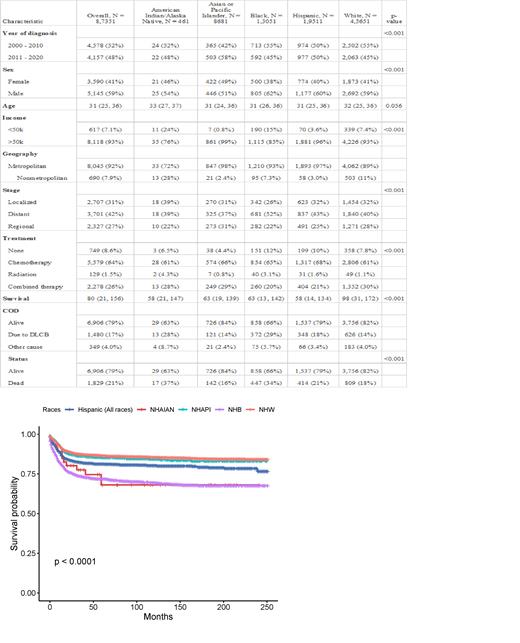Background
Diffuse Large B-Cell Lymphoma (DLBCL) is an aggressive subtype of non-Hodgkin lymphoma, and generally occurs most frequently in Whites, with a median age of 64 years 1. Adolescent and Young Adult (AYA) cancer is defined as cancer in individuals 15 to 39 years old 2. There is paucity of data on racial and ethnic disparities in the incidence of DLBCL in AYA. We aim to determine the influence of race on the incidence and survival outcomes of DLBCL in the AYA cohort.
Methods
Data from the Surveillance, Epidemiology, and End Results (SEER) 17 Research Plus database program was utilized to obtain the annual percentage change (APC) in incidence of DLBCL from 2000 - 2020 for patients aged 15 - 39 years (AYA group). Patient characteristics were expressed in proportions (%). The Kaplan Meier method was used to determine overall survival (OS) and cancer-specific survival (CSS). Cox regression was performed to determine predictors of survival. A p-value ≤0.05 was considered statistically significant.
Results
We identified a total of 8735 AYA patients diagnosed with DLBCL (see Table). The proportion of patients with DLBCL decreased the most in Non Hispanic Blacks (NHB, 45% vs 55%, p-value ≤0.001) and Non-Hispanic Whites (NHW, 45% vs 55%, p-value ≤0.001), followed by Non-Hispanic American Indian/Alaska Natives (NHAIAN, 48% vs 52%, p-value ≤0.001). No change was noted in the Hispanic (all races) group (50% vs 50%, p-value ≤0.001). The Non-Hispanic Asian/Pacific Islander (NHAPI) group showed the highest proportion of patients with DLBCL (58%) in 2011-2020 compared to 2000-2010 (42%), p-value ≤0.001.
Over the study period (2000 - 2020), there was a significant decrease in the yearly incidence of DLBCL in the overall AYA cohort (APC: -0.5%, p <0.05). This reduction was most pronounced in NHB (APC: -1.4%, p-value ≤0.001), followed by Hispanics, all races (APC: -0.65%, p-value ≤0.001) and NHW (-0.57%, p ≤0.04). However, there was a significant increase in the incidence of DLBCL in NHAPI (APC: 1.88%, p-value ≤0.001) during the same time period.
OS for NHAIAN was 58 months (95% CI: 21-147, p ≤0.001), 63 months (95% CI: 19-139, p-value ≤0.001) for NHAPI; 63 months (95% CI: 13-142, p ≤0.001) for NHB; 58 months (95% CI 14-134, p≤0.001) for Hispanics, all races; and 98 months (95% CI: 31-172, p≤0.001) for NHW.
The 5 and 10-year CSS were 86.5% and 85.4% for NHW (p-value ≤0.001); 85.4% and 84.4% for NHAPI (p ≤0.001); 81.3% and 80.3% for Hispanics, all races (p ≤0.001); 68.1% and 68.1% (p ≤0.001) for NHAIAN; and 71.9% and 69.4% for NHB (p-value ≤0.001) (see Figure).In the multivariable model, NHB (HR = 1.91, 95%, CI: 1.70-2.15, p ≤0.001), NHAIAN (HR = 2.09, 95% CI: 1.29-3.38, p≤0.003) and Hispanic, all races (HR 1.35, 95% CI: 1.20-1.53, p≤0.001) were associated with reduced odds of survival, compared to NHW.
Conclusion
There is a significant racial/ethnic disparity in the incidence and outcomes of DLBCL among AYA patients. Increase in incidence of DLBCL was observed only in NHAPI. Despite the significant improvement in the incidence of DLBCL in NHB over the years, odds of survival remain poorer than other racial/ethnic groups, except NHAIAN. More studies are needed to explore the reasons for these racial differences and more concerted efforts are needed to improve outcomes among AYA patients.
References
1. Padala SA, Kallam A. Diffuse Large B-Cell Lymphoma. [Updated 2023 Apr 24]. In: StatPearls [Internet]. Treasure Island (FL): StatPearls Publishing; 2023 Jan-. Available from: https://www.ncbi.nlm.nih.gov/books/NBK557796/
2. Turgeman I, West H (Jack). Adolescents and Young Adults With Cancer. JAMA Oncology. 2023;9(3):440-440. doi:10.1001/jamaoncol.2022.6132
Disclosures
Becerra:Grunenthal Colombiana SA: Ended employment in the past 24 months.


This feature is available to Subscribers Only
Sign In or Create an Account Close Modal